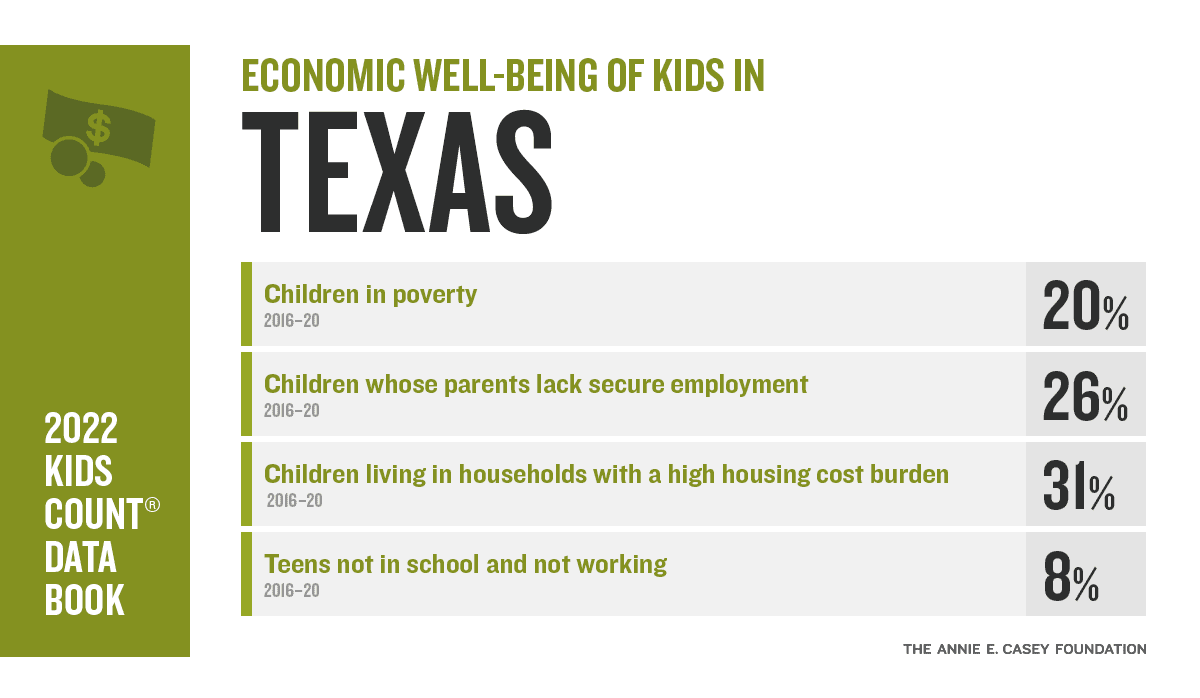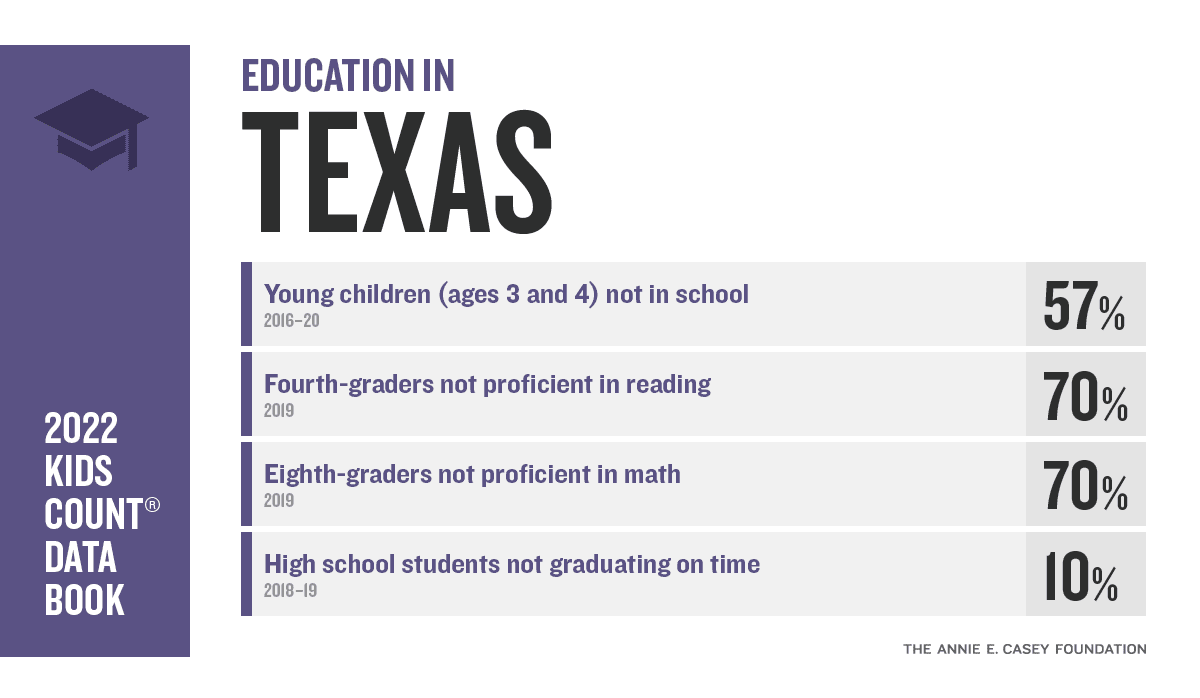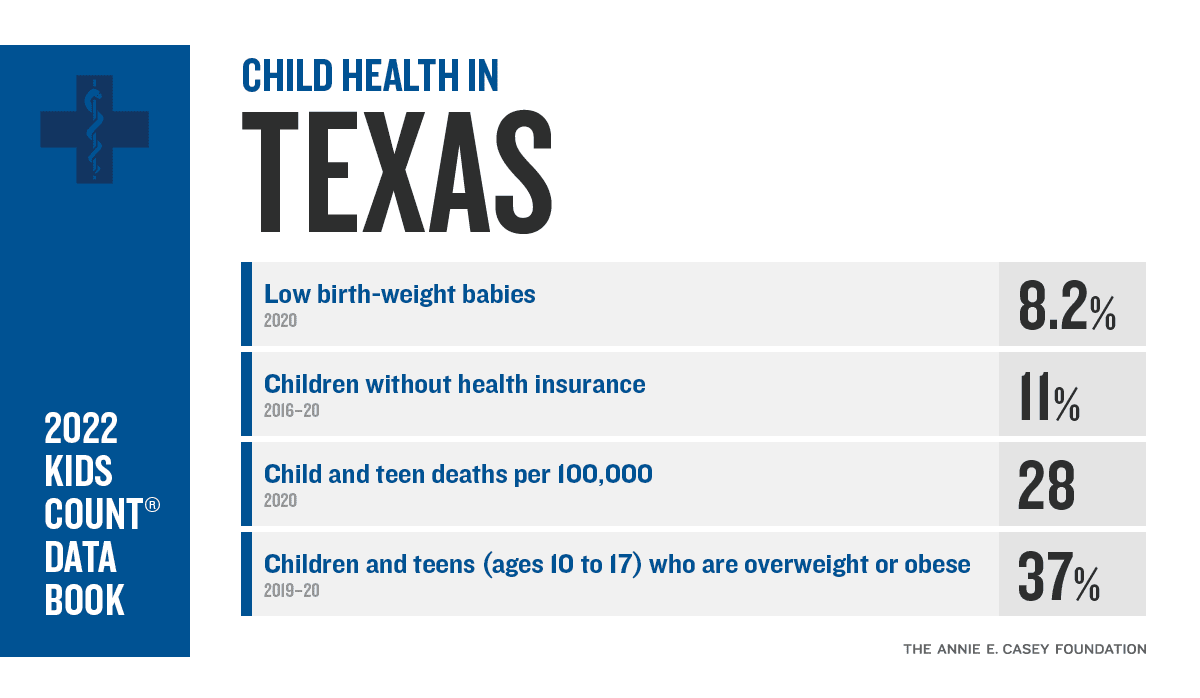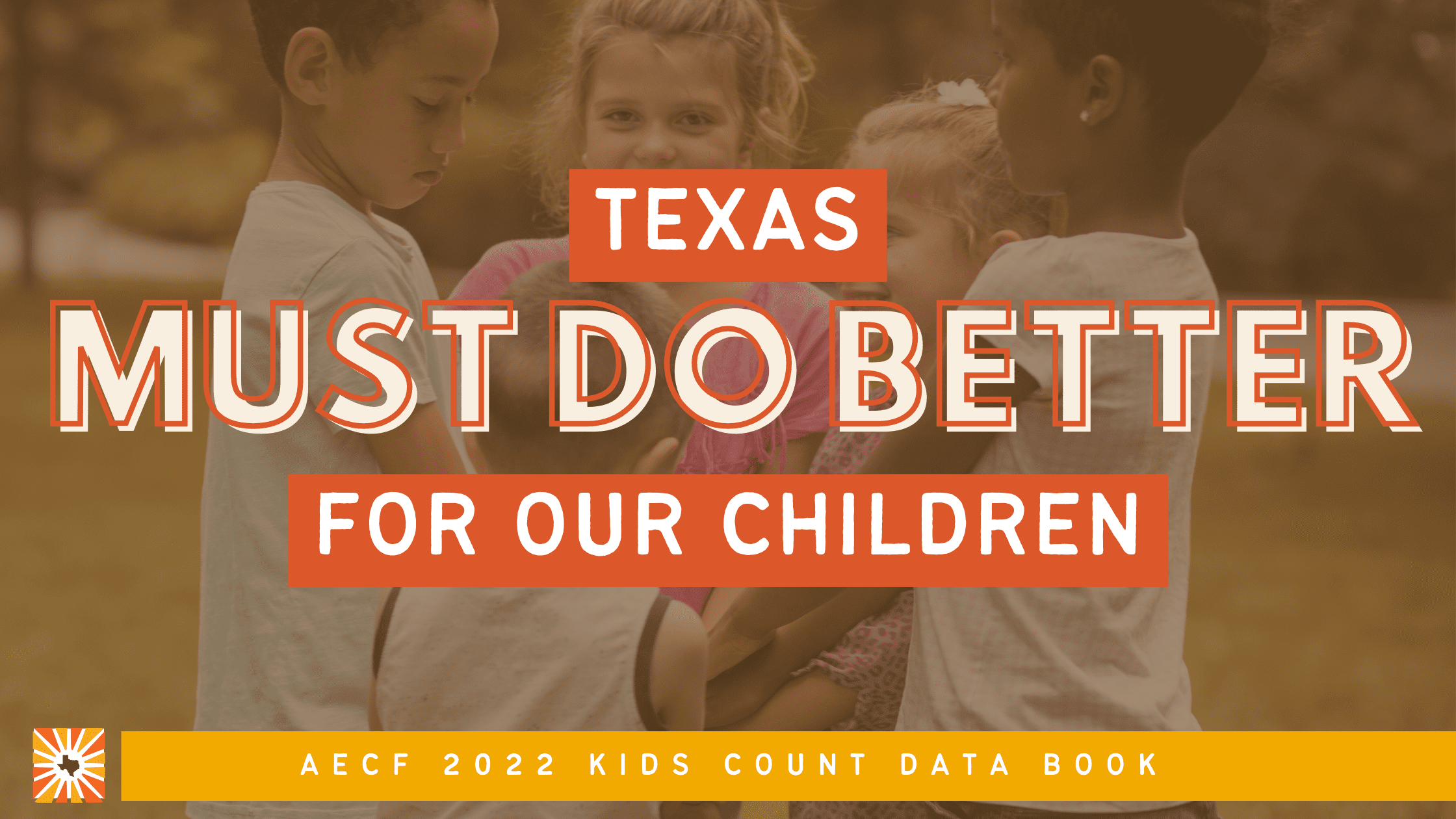The Annie E. Casey Foundation released its 2022 KIDS COUNT® Data Book today. The report includes recent household data for all 50 states and analyzes how children and families are faring. According to the report, Texas ranks 45th in the nation for overall child well-being and continues to rank in the bottom half in all four child well-being categories (economic, education, health, and family and community). New this year, the report also examined youth mental health across states. Data from the report confirm that Texas leaders must take action to ensure all Texas children are able to live healthy, happy lives.
Texas Children Deserve Economic Security
Texas Economic Well-being Ranking: 36
While child poverty has gone down in Texas (decreasing by 20% between 2012 and 2020), Texas continues to rank among the bottom half of all states (37th for child poverty). Racial disparities also continue among children and their families due to systemic racism. About one in four Black and Latino children experienced poverty in 2020, at 26% and 27% respectively, compared to 9% of white children.

In 2020, over 1.9 million Texas children lived in families where no parent had full-time, year-round employment, and almost a third of Texas children lived in households that spend over 30% of their income on housing. The pandemic has exacerbated the economic challenges Texas families and children were already facing. Policymakers and leaders must commit to improving economic security for all Texas children and their families. For example, legislators can make the Child Tax Credit permanent so that families can better support themselves. Over 6.6 million Texas children would benefit from a Child Tax Credit expansion, and about half a million would be lifted out of poverty.
Education Must Be a Priority
Texas Education Ranking: 33
Education leads to better life outcomes for children, and beginning that educational journey early on is beneficial. The percentage of three- and four-year-olds attending pre-K in Texas has not changed since 2012, per the Annie E. Casey Foundation. Over half of all three- and four-year-olds in Texas did not attend school in 2020 (57%, compared to 53% nationally — although national pre-K enrollment did drop during the 2020-2021 school year for the first time in 20 years due to the pandemic). Studies show that pre-K programs benefit young children as well as Texas as a whole. In fact, pre-K saves Texas an estimated $142 million each year, because children that attend pre-K are less likely to be retained or participate in special education programs in the first, second, or third grades. While Texas legislators passed House Bill 3 in 2019 requiring full-day pre-K for four-year-olds, the bill did not change the structure of pre-K funding from half-day levels. Texas policymakers should provide additional funding to support full-day pre-K programs to ensure young children are receiving a quality start to their education.
Like last year’s report, this year’s report shows that 70% of fourth graders in Texas were not proficient in reading, and 70% of eighth graders were not proficient in math. Inequitable school funding directly impacts students, with students of color disproportionately experiencing the negative effects. All children deserve a high-quality education, whether white, Black, or brown. Texas can make sure that all children have access to high-quality education by establishing sustainable and predictable funding for schools. Well-funded schools should be able to fairly pay and hire more teachers and school counselors, commit to smaller classroom sizes, invest in special education and bilingual/English learning programs, and offer a wider variety of courses.
Texas Needs Better Health Coverage and Access to Mental Health Services
Texas Health Ranking: 48
Texas continues to rank worst in the nation for children’s health insurance coverage, with 11% of Texas children uninsured in 2020, over twice the national rate. Health insurance largely determines whether children and families are able to receive the care they need.
This year’s data book highlights the mental health crisis that children and youth are experiencing. The report emphasizes that mental health is a critical part of the overall health of children and youth, encompassing the emotional, psychological, and social well-being needed to thrive. In 2020, over half a million Texas children ages 3-17 experienced depression or anxiety, a 23% increase from 2016. Black and Latino children experienced the largest increases in depression and anxiety between 2016 and 2020.
Children of color disproportionately experience mental health and wellness problems. Data from the report show that in 2019, 10% of all high school students in Texas reported attempting suicide (compared to the national average of 9%), and 12% of Black high school students and 10% of Latino students reported attempting suicide. New data from the 2021 Youth Risk and Behavior Survey (YRBS) show that even more children of color attempted suicide in 2021, with 14% of Black, 13% of Latino, and 16% of multiracial high school students reporting attempted suicide. LGBTQ youth are also more likely to experience adverse mental health outcomes compared to non-LGBTQ youth. Of Texas students that identified as gay, lesbian, or bisexual, 22% reported attempting suicide, compared to 8% of straight students in 2019. While the suicide attempt rate remained the same for straight students in 2021, it increased to 25% for lesbian, gay, and bisexual students.
Children and youth today are facing unprecedented challenges, and the pandemic has worsened these struggles. Policymakers must make sure every Texas child has health insurance to afford mental health services, that those services are easily accessible, and that they take into account all children’s unique experiences and identities.
Families and Communities Make our State
Texas Family and Community Ranking: 47
Over 900,000 Texas children live in high-poverty areas. Discriminatory practices, such as redlining, have resulted in children and families of color being more likely to live in areas with high poverty rates. People living in high-poverty areas are more likely to lack access to resources that are known to lead to better opportunities, such as well-funded schools and community centers. Further, children who live in under-resourced communities may experience additional stress from safety and security concerns. Data from the 2021 YRBS show that 13% of Texas children did not go to school because they felt unsafe. Latino children were most likely to skip school due to safety concerns, at 17%, compared to 8% of white children. The data also show that LGBTQ students are more likely to feel unsafe at school, as 17% of gay, lesbian, and bisexual students reported skipping school due to safety concerns compared to 11% of straight students.
It is high time that Texas leaders prioritize children and families. Regardless of race, ethnicity, or zip code, all Texas children deserve to feel safe and supported in their communities. State policymakers can invest in families and communities by expanding income support, such as by enacting a state Earned Income Tax Credit (EITC) similar to Washington State’s Working Families Tax Credit.
Looking to a Better Future
Children are our future. We must give them the tools and resources necessary to thrive, including mental health support when needed. Access to basic needs — such as health care, food, education, stable housing, and safe neighborhoods — are essential to children’s growth and stability. When children are well-supported and able to prosper, Texas prospers.
About the Report
The KIDS COUNT Data Book is a 50-state report developed by the Annie E. Casey Foundation to analyze how families have fared between the Great Recession and the COVID-19 crisis. The Annie E. Casey Foundation uses sixteen indicators across four areas — economic well-being, education, health, and family and community — to measure child well-being in states and collectively as a nation.
Read the full report here.




